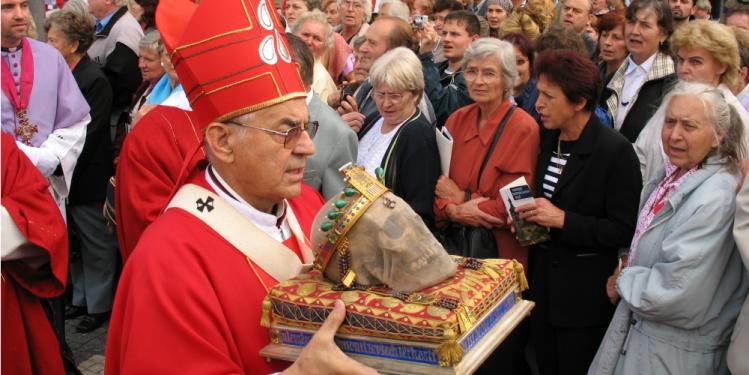
My childhood is one that historian and ethnographer Robert Orsi could appreciate. At home and at school, the unseen God was made a living presence through persistent remembrance in word, gesture, and image. In the sprawling cemetery that was my neighborhood playground, the dead were also very much present to me, and I often cringed as friends trampled thoughtlessly over their graves. I grew up in the 1970s and ’80s, by which time such an orientation toward invisible beings was supposed to have subsided, at least within the type of white, middle-class, reasonably well-educated family in which I was raised. And yet it didn’t occur to me then, nor does it today, that my experience was somehow anomalous. Indeed, the whole point of Orsi’s most recent book—to my mind, his finest—is to establish that, regardless of how fervently many modern elites have wished to banish unseen but living presences, these presences are stubborn and will not retreat.
With the publication of The Madonna of 115th Street, his now thirty-year-old study of piety in Italian Harlem, Orsi established himself as an insightful interpreter of U.S. Catholic life and developed a reputation as a trendsetter in religious history. As he exposed the intricate links between sacred and secular in the lives of immigrants and their progeny, he demonstrated a refined capacity to see what others had missed. He revealed, for example, how an annual feast honoring Our Lady of Mount Carmel both mirrored and sacralized the complex, often fraught gender relations that structured life among Harlem’s Italian-Americans in the first half of the twentieth century. Where scholars had once assumed that spiritual authority rested solely with the clergy, Orsi delved into the inner lives of ordinary people and demonstrated that their rich, though not necessarily orthodox, “theology of the streets” was at least as influential as the theology of catechisms and encyclicals. Others soon followed Orsi’s lead in taking popular religious life seriously, and subsequently, research in U.S. Catholic history became not only more dynamic and interesting, but also more true to the experience of ordinary believers.
History and Presence extends directly from Orsi’s pioneering work more than a generation ago. Then, he aimed to highlight the tension between the theology of the streets and official church pronouncements. Now, he explores a different tension: whereas ordinary believers continue to bear witness to gods and spirits and experience both advantages and challenges that extend from relationships with transcendent beings, intellectual and cultural leaders today habitually deny the very existence of such beings, disparaging and marginalizing the masses who put faith in them. Casting his sympathy with the masses, Orsi invites contemporary scholars to “approach history and culture with the gods fully present”—that is, he invites them to suspend their skepticism and take seriously the idea that engagements with transcendent powers have real-life consequences for people. Doing so, he argues, will enable secular-minded intellectuals to grasp the profound power of religious experience and its capacity to shape a host of human behaviors that, in turn, shape culture itself, even if often in subtle and unexpected ways.
Orsi’s sympathetic approach could be applied across a full spectrum of religious traditions, but the multiple case studies that make up this book each explore some element of Catholicism, with its strong attachment to mediating divine power through physical objects. One chapter narrates the story of a young woman, diagnosed with cancer in the 1990s, seeking a cure both through conventional medicine and through the power of a bag of “holy dirt” extracted from a two-hundred-year-old Catholic shrine at Chimayo, New Mexico. Another investigates an early-twentieth-century woman’s collection of prayer cards bearing images of Mary and the saints, objects that operated like a photo album and enabled her to contemplate and cultivate connections to heavenly friends and intercessors. Orsi skillfully develops these intimate spiritual histories into evocative expositions of how millions upon millions of others, past and present, have used objects to mediate meaningful spiritual connections that place their lives within webs of transcendent meaning.
The book’s two most thought-provoking sections explore recent changes in religious practices surrounding death and, in a somewhat unexpected turn, the effects of clerical sexual abuse on the spiritual lives of victims. In a chapter titled “The Dead in the Presence of the Living,” Orsi examines a traditional “Catholic way of death,” which long affirmed enduring ties to the beloved dead even as it encouraged fulsome grief at their absence. In his judgment, post–Vatican II reforms of the funeral liturgy suppressed this traditional approach, playing down ongoing presence and papering over grief by emphasizing the joy of Resurrection. Yet in this chapter, Orsi reverently gives voice to people who carry on informal, home-based patterns of ritual mourning that affirm the dead as “present in the affairs of everyday life” and, to his mind, outstrip the church’s contemporary rites in their ability to honor the pain of bereavement.
The final chapter employs interviews with clerical sexual-abuse survivors to map a spiritual typology of how, as adults, they experience God’s presence and absence. Unlike other believers, he writes, survivors often experience churches and shrines not as locations for life-giving encounters with the divine, but as places where childhood trauma is “present again” and God’s absence becomes palpable. At the same time, even interviewees who long ago stopped attending Mass attest, sometimes to their own surprise, to the enduring solace they experience in the real presence in the Eucharist. “The Eucharist is tough to shake,” attests one victim.
History and Presence powerfully demonstrates that, despite naysayers’ protests, “to be in relationship with special beings really present is as old as the species and as new as every human’s infancy.” Religious experience is tough to shake.
History and Presence
Robert A. Orsi
Harvard University Press, $29.95, 367 pp.

